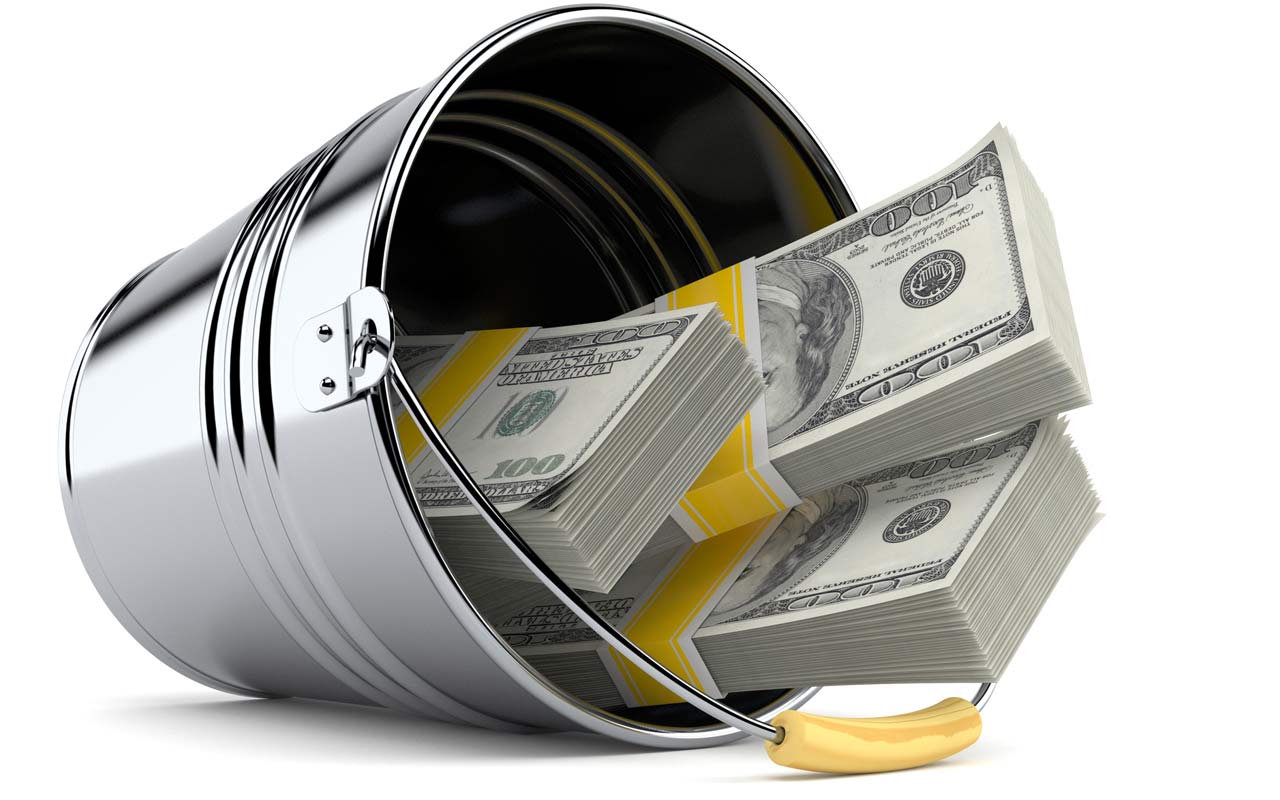7 Ways to Protect Your Retirement Nest Egg in a Volatile Stock Market
After a long stretch of calm and a relentless rally, the stock market appears to be taking a breather.

After a long stretch of calm and a relentless rally, the stock market appears to be taking a breather. No one should be surprised -- unless you’re surprised it took so long for this bull market to take some downtime. Stock market corrections, typically defined as a loss between 10% and 20% from the peak, occur about every two years, on average. The last one began in May 2015, so we’re due, especially considering that the Standard & Poor's 500 index trades at about 18 times estimated corporate earnings for the coming 12 months, above the five-year average of 16 and the 10-year average of 14. Get used to a rockier market, says Jim Stack, president of InvesTech Research and Stack Financial Management “The road ahead will be more volatile with increasing risk,” he says.
When a market is ready to correct, it will seize on a trigger -- and this market has plenty to choose from. Worries include some warning signs of inflation, with wages ticking higher. Bond yields are rising, making stocks look even more expensive in comparison and raising fears that higher rates could eventually crimp economic growth. All eyes are on a new Federal Reserve chief as the central bank navigates a tighter monetary policy in 2018. And then there’s the partisan divide in Washington, with intermittent threats of a government shutdown, not to mention escalating nuclear tensions with North Korea. Whatever the cause, any market drop is particularly worrisome for retirees and near-retirees, who have less time to make up for losses. Here are seven tips to help you survive any turmoil.
Disclaimer
This is an updated version of a story originally published in 2017.

Don't Panic
One of the important lessons from the devastating 2007-09 downturn is that even in the worst of times, "recoveries happen within a reasonable period," says financial planner Cicily Maton, of The Planning Center, in Chicago. Since 1945, it has taken an average of just four months to recover from market declines of 10% to 20%. Bear markets (resulting in losses of 20% or more) have taken an average of 25 months to break even. Fight the urge to cut and run, and avoid selling your depreciated stocks, if you can. If you are in your seventies, remember that you have until Dec. 31 to take required minimum distributions from your retirement accounts.

Keep Your Portfolio on Track
Even retirees should have an investment horizon long enough to weather this storm or whatever the market can dish out. For a retirement that can last decades, T. Rowe Price recommends that new retirees keep 40% to 60% of their assets in stocks. And because stocks stand up to inflation better than bonds and cash over time, even 90-year-olds should keep at least 20% of their assets in stocks.
If you've been regularly monitoring your portfolio, you've already been cutting back on stocks periodically over the past few years. Now is a particularly good time to revisit your investment mix to ensure that it is consistent with your tolerance for risk. During the bull market, "people were getting comfortable with those returns and may have let their stock allocation drift higher," says Maria Bruno, a senior investment strategist at Vanguard. "We've been reminding them to rebalance."

Make Sure You're Diversified
When stock prices are being pummeled, bonds are often pushed higher by investors seeking a safe place to hide. That's been a bit tricky recently, with bond prices falling as yields rise (yields and prices move in opposite directions). Nonetheless, a diversified portfolio is your best defense against the ups and downs of any single assets class or industry sector. In general, investors should own a mix of domestic and foreign bonds and U.S. and overseas stocks. And within the stock allocation, you should have a variety of market sectors. No single sector should claim more than 5% to 10% of your holdings, says T. Rowe Price senior financial planner Judith Ward.
Also remember that the headlines are not about you, says Ward. Retirees, especially, are likely to have a healthy mix of bonds and cash in their accounts to temper stock market declines. The market is not a monolith, and some of your stock holdings may buck the downtrend.

Stick With High-Quality Holdings
- This is no time to speculate. Look for companies with dependable earnings, impeccable balance sheets and healthy dividends -- or funds that invest in such companies. T. Rowe Price Dividend Growth (PRDGX) is a member of the Kiplinger 25, making it one of our favorite no-load mutual funds. It delivers steady returns with below-average volatility by focusing on sturdy companies that dominate their businesses and pay out reliable and rising dividends. PowerShares S&P 500 Low Volatility Portfolio ETF (SPLV) is a good choice for exchange-traded fund investors.

Tap Your Cash Bucket
Instead of dumping stocks, use Social Security and any annuities, plus the portion of your portfolio that comprises cash and short-term CDs, to meet your expenses. Some financial advisers recommend creating three "buckets" of investments: One with cash and short-term CDs; the second with short- and intermediate-term bonds; and the third with stock and bond funds. Relying on the first bucket will leave the stocks-and-bonds bucket of your portfolio intact. If you've planned for the inevitable downturns (you did, right?), you should have enough in cash and cash-like investments to cover two to three years' worth of living expenses. Eventually, you can use the second two buckets to replenish the first.

Rethink Your Withdrawal Strategy
Don't rely blindly on a rule of thumb that bases its assumptions on historical returns rather than current conditions. For instance, the 4% rule -- a withdrawal strategy based on back-testing 30-year periods starting in 1926 -- says you can safely take 4% of your total portfolio in the first year of retirement and in subsequent years, adjusted for inflation. Now, with stocks down and 10-year Treasury bonds yielding 2.8%, you might be wise to scale back distributions to, say, 3% or less of total assets (plus an inflation adjustment) or to take 4% and skip the inflation adjustment.
Such measures are especially important if you're at the beginning of your retirement. An unrealistic first-year withdrawal during a bear market could cripple your portfolio's potential for long-term growth. "Today, retirement is very expensive," says David Blanchett, head of retirement research at Morningstar Investment Management, which provides retirement consulting and investing services. "The key is to be flexible."
If you don't have other income to offset lower withdrawals, consider deferring gifts, trips and other discretionary expenditures until the market stabilizes. Also keep in mind that your spending changes -- and typically declines -- in retirement. You may find that cutting back is more doable than you think, says Blanchett.

Postpone Retirement
Sound drastic? Maybe so, but "delaying retirement does an amazing amount for improving retirement success," says Blanchett of Morningstar Investment Management. Not only do you have more time to save, including making catch-up contributions to your retirement accounts, but you're also letting the money in your accounts grow, and you have fewer years during which you must rely on savings once you do retire. "Working longer really reduces the stress on your portfolio," he says.
Get Kiplinger Today newsletter — free
Profit and prosper with the best of Kiplinger's advice on investing, taxes, retirement, personal finance and much more. Delivered daily. Enter your email in the box and click Sign Me Up.

Anne Kates Smith brings Wall Street to Main Street, with decades of experience covering investments and personal finance for real people trying to navigate fast-changing markets, preserve financial security or plan for the future. She oversees the magazine's investing coverage, authors Kiplinger’s biannual stock-market outlooks and writes the "Your Mind and Your Money" column, a take on behavioral finance and how investors can get out of their own way. Smith began her journalism career as a writer and columnist for USA Today. Prior to joining Kiplinger, she was a senior editor at U.S. News & World Report and a contributing columnist for TheStreet. Smith is a graduate of St. John's College in Annapolis, Md., the third-oldest college in America.
-
 Stock Market Today: Great Power Affairs Mesmerize Markets
Stock Market Today: Great Power Affairs Mesmerize MarketsThe U.S. and China are at least talking about talking about tariffs, and investors, traders and speculators are showing a little less fear.
By David Dittman
-
 Is Walmart Plus Worth It?
Is Walmart Plus Worth It?There are tons of exciting Walmart Plus benefits – but are they worth the $98 annual fee?
By Rachael Green
-
 Stock Market Today: Great Power Affairs Mesmerize Markets
Stock Market Today: Great Power Affairs Mesmerize MarketsThe U.S. and China are at least talking about talking about tariffs, and investors, traders and speculators are showing a little less fear.
By David Dittman
-
 Stock Market Today: Stocks Rise on Good Volatility
Stock Market Today: Stocks Rise on Good VolatilityInvestors, traders and speculators continue to process the "known unknown" of global tariff-and-trade war negotiations.
By David Dittman
-
 Stock Market Today: Trump Retreats, Markets Rejoice
Stock Market Today: Trump Retreats, Markets RejoiceStocks rally, yields soften, the dollar rises, and even beaten-down names enjoy the wages of potential trade peace.
By David Dittman
-
 Stock Market Today: Stocks Soar on China Trade Talk Hopes
Stock Market Today: Stocks Soar on China Trade Talk HopesTreasury Secretary Bessent said current U.S.-China trade relations are unsustainable and signaled hopes for negotiations.
By Karee Venema
-
 Stock Market Today: Dow Drops 971 Points as Powell Pressure Ramps Up
Stock Market Today: Dow Drops 971 Points as Powell Pressure Ramps UpPresident Trump is increasing his attacks against Jerome Powell, insisting the Fed chair cut interest rates.
By Karee Venema
-
 Stock Market Today: No 'Powell Put'? No Problem
Stock Market Today: No 'Powell Put'? No ProblemInvestors, traders and speculators look beyond both another Trump post and more signs of slowing economic activity.
By David Dittman
-
 What Is the Buffett Indicator?
What Is the Buffett Indicator?"It is better to be roughly right than precisely wrong," writes Carveth Read in "Logic: Deductive and Inductive." That's the premise of the Buffett Indicator.
By Charles Lewis Sizemore, CFA
-
 Stock Market Today: Dow Drops 699 Points After Powell Speech
Stock Market Today: Dow Drops 699 Points After Powell SpeechFed Chair Powell warned of a slowing economy and higher inflation but said the central bank isn't ready to cut rates just yet.
By Karee Venema

